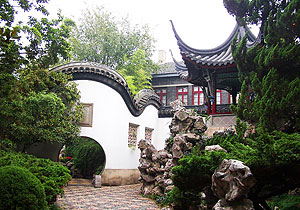Presidential Palace

Presidential Palace has been the seat of a Ming Dynasty mansion, the two successive ducal palaces, the Taiping army mansion of Heavenly King before it was reconstructed into the modern government offices of Sun Yat-sen's provisional government in 1912, the Nationalist government (1927-37 and 1946-49) and Communist government office in 1949. Bearing the heavy weight of Nanjing changing history, the palace has ended its power seat role and settled down to serve as a historic site museum on the completion of a massive renovation in 1980.
The 90,000-km museum is a compound of three parts linked by the winding corridors: the central area and its flank parts-- west area and east area.
The central area structures is the buildings mainly for Chiang Kai-shek, the leader of the Nationalist Party to handle the affairs and receive the guests. Many details are behind its simply-decorated rooms. One reception room in simple decor was for meeting domestic guests while the other relatively fancy one was for greeting foreign (American) guests. These two differently decorated rooms subtly reveal Chiang's political attitudes of the day. In Chiang Kai-shek office building, there is the office desk set sideways by the cautious Chiang to promptly respond to any dangers and an interesting 1934 old-fashioned hand-operated Otis elevator that is restored and yet out of tourist service.
In the west area, there are western-style buildings full of Sun Yat-sen's traces and the classical West Garden (Xu Garden). Sun Yat-sen's brief stay can be traced in the rooms with their original simple appearance. His pioneer revolutionary cause can be browsed in the Dr. Sun documentaries hall. West Garden is a tranquil shelter with saturated greenery, carp pond, rock formations, the Taiping Heavenly Kingdom's stone boat on the vase-shape lake, and the overlook pavilion with the whole garden sight, etc.
The east area covers the rebuilt East Garden (Fu Garden), former executive offices and Qing dynasty Taiping memorial hall which displays the Qing dynasty Taiping Heavenly Kingdom army relics covering leader statue, palace model as well as the army weapons.
The offices with almost the same things in the palace can easily become boring. If you want more than just passing by, background information preparation or an experienced guide will make the visit more fruitful.
Right next to the Presidential Palace, a trendy spot known as 1912 (the year of establishing Republic of China and witnessing the most glorious period in Nanjing history) full of bars, coffee shops, and restaurants and clubs well blend the past and present ambience as its surroundings.